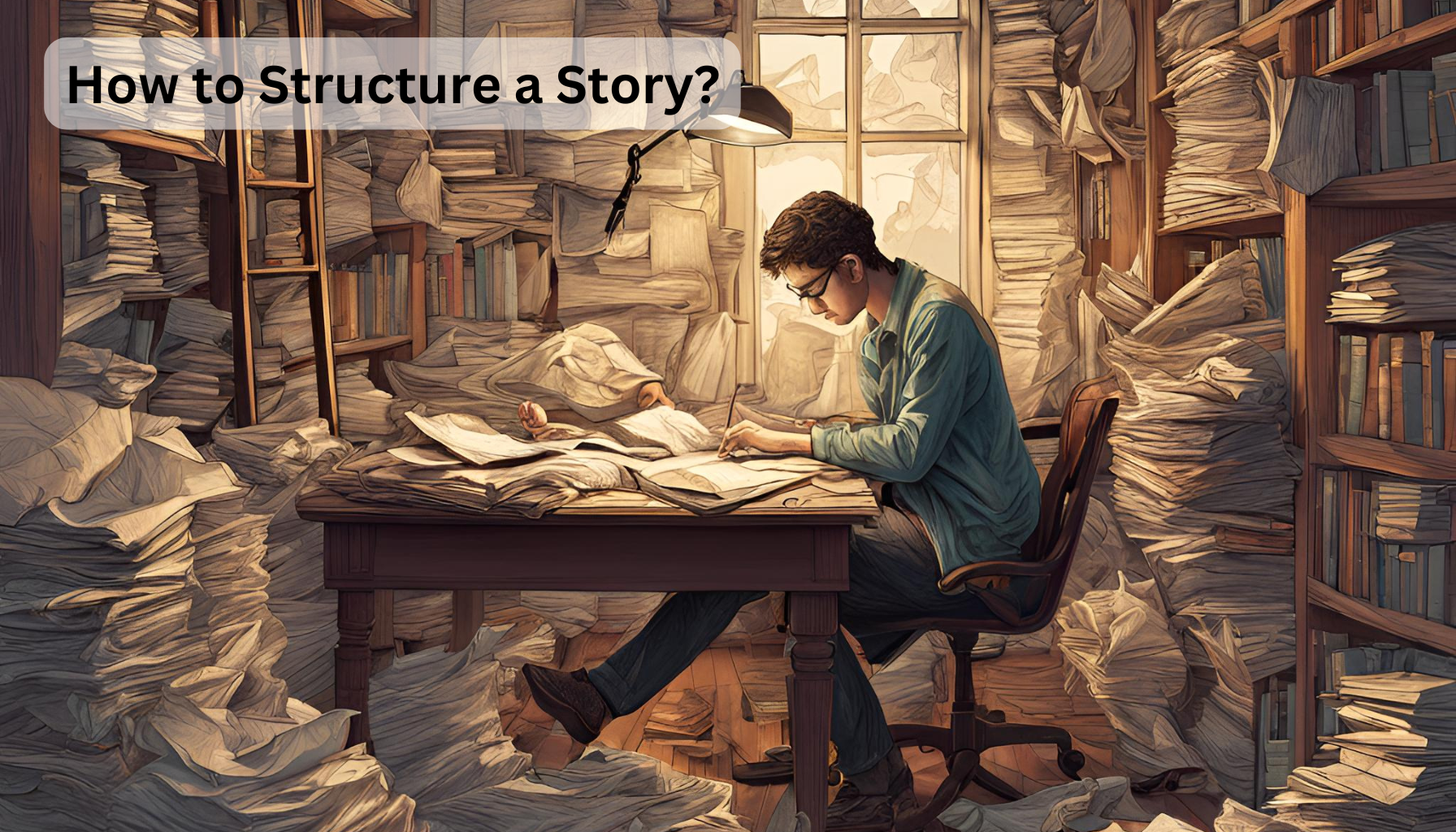How to Structure a Story?

No matter what kind of writer you or what genre you write in, you need to begin with an idea of where you will go with your story.
We all know the importance of a powerful beginning, middle, and end, but there’s a bit more to consider in terms of story structure.
The good news is that there are several basic story structures to choose from.
Today, we’ll share the 7 basic story structures that many top authors have used.
It’s all about finding what works best for you and your idea.
What is Story Structure?
Story structure is the bones that you will build your story around. It’s the foundation that helps you craft and organizes the conflict, climax, and resolution of your story. How you unfold your story builds tension and creates drama that will hook your readers from beginning to end.
Elements of a Story Structure
While there are 7 different types of story structures, they all have the same basic elements. Here’s what you will find in every story structure:
Opening
The opener of your story is where you reveal who the story is about. It’s also where you set the stage for your story’s primary challenge and the dilemma your character faces. With your opener, you must justify the contents of the entire story. This is where you grab your reader and get them invested in the journey of your main character.
A Pivotal Moment
There must be a catalyst that forces your character to act, a single incident that changes the course of the entire story. Here you must layout dire consequences for failing. Throughout your story, your character must then fight to prevent the dire consequence.
Challenges that Elevate Tension
Then, there will be a sequence of crises that build mounting tension. As your character tries his best to solve the problem at hand, things get progressively worse. All of these challenges are crucial for your character arc because along with the way he is learning new skills.
Climax
The climax is not the end of your story, but it feels like everything is hopeless.
The End
Finally, provide your readers with a satisfying ending. The End concludes your story, and it is here that your character ultimately fails or succeeds based on everything he has learned throughout. Make sure to tie up any loose ends to give your reader a satisfying ending that still wants him hoping for a sequel.
Story Structures
Classic Story Structure from Dean Koontz
This story structure is simple and only has 4 primary steps.
- Thrust your main character into “terrible trouble” as soon as you can. Terrible trouble depends on your genre, but it is the worst possible situation you can think of for your main character to be in. The situation must have high stakes, and only present it once you’ve gotten readers to care about your protagonist.
- Every move your character makes to escape the trouble only worsens the situation. Don’t make things too easy for your main character. Add logical complications that proceed logically, with the situation growing worse and worse.
- Make the situation appear hopeless. It should seem like your character cannot escape.
- Your hero will then succeed or fail in the end.
In Medias Res
This means “in the midst of things”. For this story structure, you begin in the middle of an event. The second your reader begins reader, he feels like he’s already in the middle of something.
The setting and backstory are layered throughout the story, as it progresses, rather than at the beginning. You cut the introduction and jump straight into the action.
This story structure helps you grasp your reader early.
The basic outline for In Medias Res is:
- Rising action
- Explanation/backstory
- Climax
- Falling action
- Resolution
The Hero’s Journey
The Hero’s Journey is a popular choice for horror, science fiction, and fantasy novels. For this structure, the character heads into unknown territory and faces obstacles and challenges before ultimately triumphing. Through the journey, the hero is transformed. The basic layout is:
- The Ordinary World
- Call to adventure, the hero leaves the ordinary world.
- Refuse the call. The hero may try to refuse the call to action due to fear.
- Meet the mentor. The hero may acquire a personal mentor.
- The hero faces obstacles and acquires allies.
- Approach the goal. The hero nears his ultimate goal.
- Face the fear. The hero faces his biggest test.
- Reward. The hero can see an end in sight after a tough adventure.
- The road back. After acquiring the reward, more dangers await, the road back is not as easy as the hero thought.
- Resurrection. The hero meets his last test, this is the true climax.
- Triumphant homecoming. The hero returns, transformed.
7-Point Story Structure
It can often help to begin with your resolution and work backward to determine the 7 points.
- Hook. where your protagonist starts.
- Plot turn 1: Introduce the conflict that propels the story to its middle.
- Pinch point 1: Apply pressure to the main character who is working toward his goal. Typically this involves facing an antagonist.
- Midpoint. Your protagonist handles the conflict with action.
- Pinch point 2: Apply more pressure to your character, making it even more difficult for him to reach his goal.
- Plot turn 2: Push your story from midpoint to resolution. At this point, the protagonist has all of the tools and confidence to achieve his goal.
- Resolution: Reach the climax of your story, and then tie up the loose ends.
The Snowflake Method by Randy Ingermanson
This structure may work best for those who enjoy outlining their stories. Here is the 10-step Snowflake Method:
- Start with a one-sentence summary of your story.
- Expand the one sentence into a full paragraph. Include details of major events.
- Now, write a one-page summary for each character.
- Expand each sentence from #2 into a full paragraph.
- Create a one-page account of the story from each main character’s perspective.
- Expand each paragraph from #4 into a full-page synopsis.
- Add to your character descriptions to create full character charts.
- Based on the summary from #6, list the scenes you need to finish your story.
- Then, write a multi-paragraph description for each scene.
- Write the first draft.
The 3 Act Structure
This method dates all the way back to ancient Greece, and it’s a common format used in Hollywood. It’s simple and to the point.
Act 1: Set Up
Introduce your main characters and set the scene. Here, you’ll include your “inciting incident”, an obstacle that shakes up your protagonist and lays the foundation for the direction of the story.
Act II: Confrontation
Introduce a seemingly small problem that unfolds to be more complicated. As your protagonist strives to solve the problem, it becomes more and more difficult.
Act III: The Resolution
Lastly, create a good ending. For the ending to be enjoyable, it must be high stakes. Throughout the story, your protagonist developed the skills and grew enough to overcome the obstacles. Finally, present a solution where your character solves the problem.
A Disturbance and Two Doorways by James Scott Bell
- Disturbance. Set up the status quo, and then create a disturbance that threatens ordinary life.
- Doorway 1. This pushes your main character to the middle of the story. Once he enters doorway one, he can only move forward.
- Doorway 2. This leads to the last battle. It often leads to disaster.
The 7 story structures above will help guide you as you write a best-selling story. It’s all about finding the best story structure for your idea and writing style.


